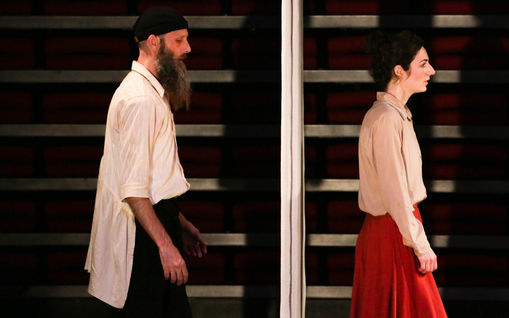About
Founder and director: Dr. Talia Perlshtein
Artistic director: Sharona Florsheim
Noga Dance Company, the first religious professional dance company established in Israel, was founded in 2009 at Orot Israel College with the aim of creating a professional framework for religious choreographers and dancers who view dance as a way of life and a channel for professional self-realization. Winner of Israel's Education Minister's prize for Jewish Culture 2017. The Company invites the creators to develop and foster a dialogue between the religious Jewish spiritual world they draw from, and each creator’s personal artistic expression, and in this it is unique. Since its establishment, the Company has performed before extensive audiences of women both from the secular public and the entire gamut of the religious-ultra-Orthodox sector. Over the years the Company has performed in major festivals and venues in Israel, including the Suzanne Dellal Centre in Tel-Aviv, Between Heaven and Earth Festival in Jerusalem, Karmiel Dance Festival, Emunah Dance Festival, and many more. The Company’s work is supported by The Israeli Ministry of Culture and Sport, Mifal Hapais -The Israeli lottery foundation for the Arts, Orot Israel Academic College of Education, and private funds. Dancers: Moria Horowitz, Bracha Miriam Lindao, Hila Rosenberg, Peri Friedman, Raaya Horovitz, Atara Elitov, Maya ben Non, Michal Madar, Nava Tehila Constantinis, Rachel Mizrahi
Works
The Movement Before - Keren Horesh Begun
Original music: Itai Dalomi Costume design: Rosie Canaan Dancers: Moria Horowitz, Ashira Allon, Bracha Miriam Liniado, Hila Rosenberg, Peri Friedman, Raaya Horovitz, Michal Shaltiel, Atara Elitov Lighting design: Noa Elran The piece raises the question of how much we are pushed to our actions, and to the movement of our life as a response to the environment, and to what extent the source of our action and movement stems from the distilled and internal desire of the open heart. Can we move freely or do we stop ourselves in the extensions of our hearts, with our own hands? The extreme changes we are required to make cause us to be optimistic, and lighthearted. Just as the butterfly's life changes radically from a caterpillar to a cocoon, and finally to a butterfly that skips lightly and happily on the "stairs of the wind" in the air. Courageously we will meet at the peak of fear and skip to the next change with great joy with reason to celebrate. Facing each other, with each other, we will continue the movement.
Hand 2 Hand - Shlomit Fundaminsky
Adaptation from the solo Big Hand Little Hand by Shlomit Fundaminsky Original music: Noam Helfer Dancers: Bracha Miriam Liniado, Ashira Allon, Michal Shaltiel, Hila Rosenberg, Peri Friedman, Moria Horowitz, Raaya Horovitz Lighting design: Noa Elran A group of women stands and waits. The air inside them, changes and shapes their world. Their age, the landscape, their house, will be built and broken down through a physical and mental state of waiting. Who are they waiting for? And why? The piece examines movement that originates from variations on waiting, the element of time is central. The movement language separates the body into its various organs, each of which functions as part of a time machine. A ticking mechanism that becomes emotion, an image, a setting and a story.
Shira’s New Home - Avital Ben-Gad
Choreography: Avital Ben-Gad Palmer Text and Directing: Irit Luz Artistic Guidance: Michal Zarka Dancers and Co-creators: Bracha Miriam Liniado, Inbar Shalev, Lital Edut, Talia Izhaki , Ruth Golan, Yasmin Mesulami Sound Editing: Avital Ben-Gad Palmer Costume and Stage Design: Michal Cappeluto Shira’s family has moved into a new home. Shira wanted to stay in the old one. She knew it really well (just as well as she knows herself). Now, in her new home, everything is in boxes. What will happen when they are opened? Will her home come out of them? Where is Shira’s home, and who is going to help her find it? Shira, the heroine of the performance, moves into a new home and contends with all these questions. She fears the change and the loss of the familiar and known. While the rest of her family are busy organizing and arranging their new home, Shira builds a little home for herself in one of the boxes and refuses to come out. In this box she keeps games and memories from her old and beloved home and in which she knew her place and the order of things around her. With the help of her family and the clues she left behind, Shira gradually manages to come out, to explore and discover her new home. In the process of contending with the move to a new home, Shira seeks to find her inner and outer home, the place where she experiences acceptance, security, and belonging. The work engages in the search for home from the physical, emotional, and spiritual aspects.
BeMechitzatech- Tzofia Tson Lor
Choreography, costume, and stage design: Tzofia Tson Lor Dancers, partners in creation: Ruth Golan, Oren Sharon Tishler Music: Roni Ivrin, Chopin Artistic guidance: Sharona Florsheim In this duet, a partition ("mechitzah") divides the space shared by two dancers - one male and one female. The partition arouses an awareness of the presence and absence of our gaze. We come to perceive how our experience of reality is partial, and we notice the partitions we have in our own lives. Whether voluntarily or forced - which separate between different parts of the same whole. Length: 50 minutes The performance is open to a mixed audience of men and women and is appropriate for religious populations.
Contact
Email: noga.dc@gmail.com
Rabi Chiya 9, Elad, Israel






















